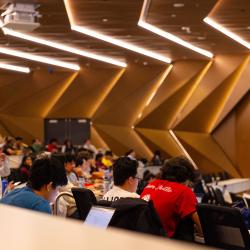Solving Real-Life Problems With Math
AMSC Ph.D. student Alice Oveson is creating a mathematical model that mimics how people decide whether to adhere to public health interventions.
Growing up, Alice Oveson was always fascinated by numbers and the certainty they provided.

“Math was special because it’s based on logic and reasoning,” she explained. “I loved how black and white it was, how you could look at things in the world and express them in a mathematical, concrete way.”
But she wasn’t totally convinced that it was her calling—not until one of her high school teachers gave her a little push in the right direction with a backhanded compliment.
“I was always a little scared of this teacher because he was strict, both about the dress code and about math,” Oveson said. “Funny enough, he told me that even though I wasn’t his smartest student, I worked the hardest. According to him, that meant that I had the potential to embark on a career in math.”
True to her teacher’s prediction, Oveson is now making waves as a Ph.D. student in the Applied Mathematics & Statistics, and Scientific Computation (AMSC) program at the University of Maryland.
Under the guidance of Mathematics Professor Abba Gumel and Physics Professor Michelle Girvan, Oveson studies behavioral epidemiology, an up-and-coming field that seeks to understand how human behavior impacts the spread of disease.
“Behavioral epidemiology combines a bunch of other subjects, from sociology to statistics,” explained Oveson, who said she chose to apply to the AMSC program due to its commitment to interdisciplinary research. “It helps us see how people’s decisions and actions can shape the progression of an epidemic.”
According to Gumel, Oveson’s work addresses a new and growing problem in public health: how people react to infectious disease in light of the spread of disinformation and increasing mistrust towards public health practitioners tasked with implementing control and mitigation measures. Oveson hopes to realistically incorporate these trends into mathematical models simulating disease transmission and control efforts.
“Alice exudes an amazing level of scientific curiosity,” said Gumel, who also holds the Michael and Eugenia Brin Endowed E-Nnovate Chair in Mathematics and joint appointments in the Department of Biology and Institute for Physical Science and Technology. “Formulating a mathematical model that reasonably mimics how humans choose to make decisions on their adherence to public health interventions is a remarkably challenging undertaking. She is determined to use mathematics, together with data analytics and computation, to solve some of the most pressing grand challenges of our time.”
Inspired by Gumel’s work in epidemiology and her own interest in human behavior, Oveson works on mathematically defining concepts like opinion dynamics—how individual opinions form and evolve over time—and applying that mathematical definition to simulation models of how epidemics grow or wane. To accomplish this, she considers three variables that impact the formation of an opinion: an individual’s own experiences, the opinions of others in the individual’s social network and current circumstances happening around the individual. Using these variables, Oveson can predict possible outcomes of a pandemic.
“Our opinions shape how we act, and they also change a lot over time, especially when the topic of our opinion is fairly new,” she explained. “For example, the first few months of COVID-19 were crucial to how we ended up reacting to the pandemic. It was during that time that we cemented our opinions on COVID-19, whether it was worthy of concern and whether we should wear masks. Opinion shifts over time influenced how COVID-19 spread.”
Oveson hopes that her work can one day help public health officials and medical workers fight pandemics by pinpointing when and where their control efforts would be most effective.
“Knowing how a person feels about wearing a mask versus if they actually wear a mask during a pandemic can tell us if things like whether mask mandates or social pressures work in curbing disease,” she said. “Math can help us understand people and how to help them and even save lives.”
Making math more accessible
Oveson’s belief in how math can help people extends well outside the ivory tower of academia. This philosophy is why she also loves teaching math and is committed to making the subject more accessible to anyone.
“There’s math in so many things we do in life,” she said. “Math has the ability to lift people up, whether it’s giving you better job prospects or just raising your self-esteem when you’ve figured out something difficult.”
Even as a student herself, Oveson has taught a wide variety of students across many institutions. Some were high schoolers looking for a tutor; others were young undergraduates taking introductory calculus courses. More recently, she was part of a UMD Department of Mathematics initiative that allowed her to bring her teaching abilities to a correctional facility in Washington, D.C.
There, she and several other volunteers from the department offered lessons to incarcerated individuals looking to build a better understanding of math concepts that could be helpful in their day-to-day lives.
“The inmates were exceptionally enthusiastic and willing to learn, more so than almost anybody else I’ve ever taught,” she said. “For them, math was something to look forward to.”
Oveson’s experience working with incarcerated students reaffirmed her passion for math. Now, she hopes to continue her math outreach to the greater community through teaching, curricula planning and behavioral epidemiology work.
“My research is really fulfilling and so are my teaching efforts,” Oveson added. “Looking back, it’s because I was lucky to meet the right teacher at the right time at every step of my education. I hope to do the same for new generations of students.”







